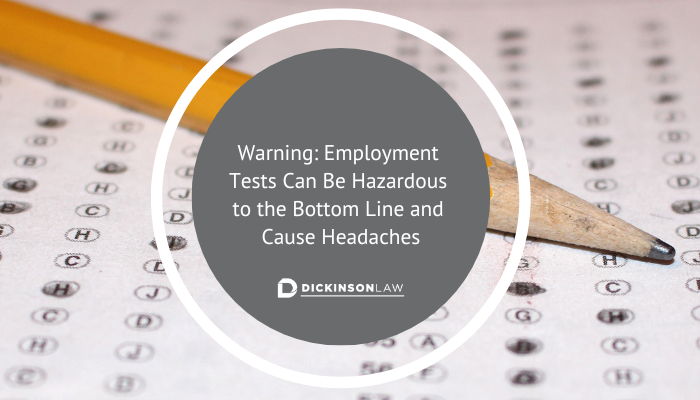Warning: Employment Tests Can Be Hazardous to the Bottom Line and Cause Headaches

Posted on 09/18/2023 at 02:32 PM by Jill Jensen-Welch
The EEOC announced recently a nationwide class action lawsuit it filed against Walmart on September 11, 2023, in the Western District of Arkansas, over an employment test that allegedly discriminated against disabled employees. It caught my attention because I abhor employment tests.
Although questions about employment tests don’t come to me very often, when they do, I try to cut to the chase and strongly discourage their use. Believe me, I get the allure of employment tests. A test that can help employers make employment decisions efficiently, and seemingly even-handedly, is to employers what catnip is to a cat. Irresistible. So, you can imagine how often clients actually listen to me and abandon their tests or dreams of tests. I don’t like tests because they create liability risks for employers if done wrong, and the administrative burdens and costs to properly choose and implement tests is usually prohibitive.
Before we get much deeper into why I hate employment tests, let’s see what this EEOC v. Walmart case is about.
Alleged Facts
In its Complaint, the EEOC alleges that in 2015, Walmart began requiring newly-hired, entry-level associates in 31 positions to go through a “Pathways Training Program” (PTP) within their first 180 days of employment. At the end of it, the new-hires had to pass a 40-question, self-administered, computer-based test called the Pathways Graduation Assessment (PGA). In 2018, the time to complete the PTP was reduced to 90 days and the PGA was reduced to 25 questions.
The new hires had to correctly answer 70% of the PGA’s questions to pass. Those who didn’t pass after three tries were discharged. Here’s the kicker: Even if the new hire had been satisfactorily performing the essential functions of their job, their employment was still terminated if they did not pass the PGA. In addition, the EEOC alleges Walmart denied or did not provide reasonable accommodations to disabled employees taking the PGA.
There are two named plaintiffs in this class action case—Glenda Scott and Jaclyn Walker. Scott was hired as an apparel associate for a Walmart store in Arkansas. Scott is deaf and communicates using sign language. She also reads at a fourth grade level. Scott failed the PGA for a third time on May 13, 2018, but she was not discharged for it until August 25, 2018. Walker was hired as an overnight stocker at a different Walmart store in Arkansas. Walker has intellectual disabilities and speech/language disabilities that substantially limited her ability to communicate, speak, read, learn, and think. Walker failed the PGA for a third time on June 24, 2018, but she was not discharged for it until August 26, 2018.
Walmart stopped using or requiring passage of the PGA on March 31, 2020.
The EEOC claims the Walmart PGA discriminated against persons with disabilities, and was not “job-related and or consistent with business necessity,” in violation of the ADA. The EEOC further claims that Walmart failed to reasonably accommodate disabled employees taking the PGA.
According to the EEOC press release, Walmart “collaborated with a third-party entity to create its PTP and the PGA. This company is not identified in the EEOC’s Complaint or press release. But the Complaint alleges that the PGA test was not validated.
Validating Tests
Typically, when an employment test is at issue, we labor and employment folks look to see if the test complies with the Uniform Guidelines on Employee Selection Procedures (UGESP). These guidelines were issued by the EEOC, the Department of Labor, and the Civil Service Commission in 1978 under the authority of Title VII and E.O. 11246 (requiring affirmative action for federal government contractors and subcontractors). The UGESP established a uniform federal government position on the use of employment tests and other selection procedures to make any employment decision. If a test has an adverse impact[1], it must undergo and pass three UGESP-required validation studies: criterion-related validity, content validity, and construct validity.
Of those who took even one Stats class in college, how many remember what these validation studies measure? Not me! Use it or lose it. I didn’t use that knowledge after graduation, so I lost it. Don’t worry, the UGESP tells us what these three studies are for:
- Criterion validity demonstrates how well the test predicts or is significantly correlated with important elements of job performance (statistical study).
- Content validity demonstrates how well the content of the test represents important aspects of the job (non-statistical study).
- Construct validity demonstrates whether the individual has identifiable characteristics associated with successful performance in the job (statistical study).
It’s like assessing the quality of a diamond. Instead of considering the clarity, color, cut, and carat weight of a diamond, we look at criterion, content, and construct validity of the test. It’s not easy to find a diamond in the rough of all the employment tests out there.
Further, the UGESP require employers to consider at least two employment tests or selection procedures that are substantially equally valid, and use the one that has the lesser adverse impact.
Do you see why I discourage employers from using employment tests? Complying with the UGESP carries a heavy and complicated administrative burden that most employers do not fully appreciate. What a headache!
ADA Standards for Evaluating Tests and Damages
Fortunately for Walmart, the UGESP do not apply to claims made under the Americans with Disabilities Act.[2] While the ADA and its regulations prohibit test and selection procedures that discriminate against persons with disabilities, neither mentions test validation studies, specifically. Even so, the EEOC’s Complaint alleges Walmart failed to “validate” the PGA.
Under the ADA, tests and selection procedures must be “job-related and consistent with business necessity.” This means the test must be a legitimate measure of an individual’s ability to perform the essential functions of the specific position held or desired, with or without reasonable accommodations. While the job-related-and-consistent-with-business-necessity standard is used when evaluating employment tests under all federal anti-discrimination laws, it stands alone, unaided by the UGESP, for ADA claims. Small comfort to Walmart.
The damage caps applicable to ADA claims may help Walmart reduce the financial impact if it settles or loses this class action. Walmart’s bottom line is so big, the cost of defending and/or losing this case may be barely noticed. The outcome might be more hazardous if the EEOC was suing your business, instead of Walmart.
Takeaways
If you’re using employment tests and, despite what I’ve said here, you won’t give them up until the EEOC or a court pries them from your cold, dead hands, here are some takeaways:
- Identify tests used with applicants in the recruiting process, as well as tests used on employees after hire, and review their validity. Don’t overlook tests embedded in computer-based training, or used by managers without HR’s knowledge, if the results of those tests factor into employment decisions.
- Be sure any employment tests in use, or under consideration, are generally “job-related and consistent with business necessity.” Re-evaluate the test under that standard with each disabled employee who fails or challenges it (because the ADA requires individualized analysis).
- Carefully vet and validate each test used, or considered, to be sure it complies with the UGESP. Even though the Walmart case doesn’t involve a challenge under the UGESP, it would have been vulnerable to such attacks if it also had had an adverse impact based on race, sex, or ethnicity.
- Be sure to notify applicants and employees that they can request reasonable accommodations with regard to the test, and then follow through with an interactive process, as needed, for disabled persons.
- Look for tests similar to the one you use, or want to use, and compare their adverse impacts and validation studies. Choose the test that has the smallest adverse impact.
- Just because you buy a test from a third party vendor, or develop the test with a third-party vendor, doesn’t mean it’s properly validated—no matter what you’re told.
- Don’t take validation studies offered by the test vendor, shove them in a drawer, and call it good. Really look at them, using an independent expert in statistical analyses of tests to advise you as to whether the test will pass muster under the UGESP.
Categories: Jill Jensen-Welch, Employment & Labor Law
Questions, Contact us today.
The material, whether written or oral (including videos) that is posted on the various blogs of Dickinson Bradshaw is not intended, nor should it be construed or relied upon, as legal advice. The opinions expressed in the various blog posting are those of the individual author, they may not reflect the opinions of the firm. Your use of the Dickinson Bradshaw blog postings does NOT create an attorney-client relationship between you and Dickinson, Bradshaw, Fowler & Hagen, P.C. or any of its attorneys. If specific legal information is needed, please retain and consult with an attorney of your own selection.







